【51Talk-用英语介绍非遗文化】人类非物质文化遗产代表作:妈祖信仰
中国非物质文化遗产英语演讲稿范文
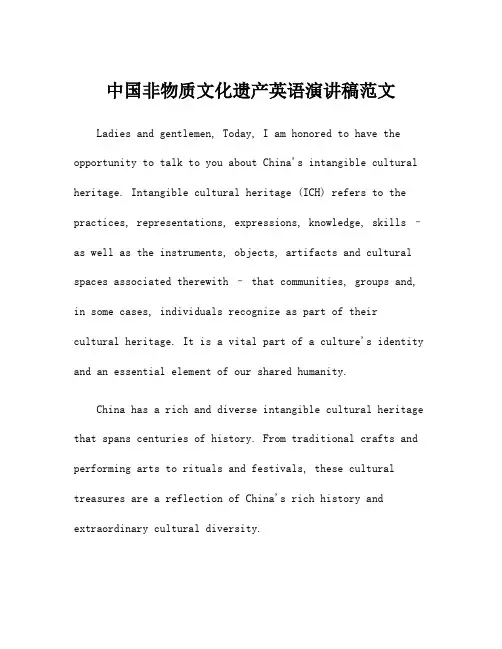
中国非物质文化遗产英语演讲稿范文Ladies and gentlemen, Today, I am honored to have the opportunity to talk to you about China's intangible cultural heritage. Intangible cultural heritage (ICH) refers to the practices, representations, expressions, knowledge, skills –as well as the instruments, objects, artifacts and cultural spaces associated therewith – that communities, groups and, in some cases, individuals recognize as part of theircultural heritage. It is a vital part of a culture's identity and an essential element of our shared humanity.China has a rich and diverse intangible cultural heritage that spans centuries of history. From traditional crafts and performing arts to rituals and festivals, these cultural treasures are a reflection of China's rich history and extraordinary cultural diversity.One of the most well-known examples of China's intangible cultural heritage is Peking Opera, a traditional form of Chinese theater that combines music, singing, mime, and acrobatics. Peking Opera has a history of over 200 years and continues to be performed to this day, enchanting audiences with its colorful costumes, elaborate makeup, and powerful performances.Another example of China's intangible cultural heritageis traditional Chinese calligraphy, which is considered a true art form that requires skill, patience, and dedication. Calligraphy has been practiced in China for thousands of years and holds a special place in Chinese culture as a means of self-expression and a reflection of one's inner thoughts and emotions.Moreover, Chinese cuisine is also an important part of China's intangible cultural heritage. Chinese cuisine is known for its varied flavors, fresh ingredients, andexquisite presentation. From spicy Sichuan cuisine todelicate Cantonese dishes, Chinese cuisine is a reflection of China's diverse regional cultures and culinary traditions.In conclusion, China's intangible cultural heritage is a precious legacy that must be preserved and celebrated. It is our responsibility to protect and promote these cultural treasures so that future generations can continue to appreciate and learn from our rich cultural heritage. Let us work together to safeguard and promote China's intangible cultural heritage for the benefit of all humanity.Thank you.。
【51Talk-用英语介绍非遗文化】人类非物质文化遗产代表作:羌年
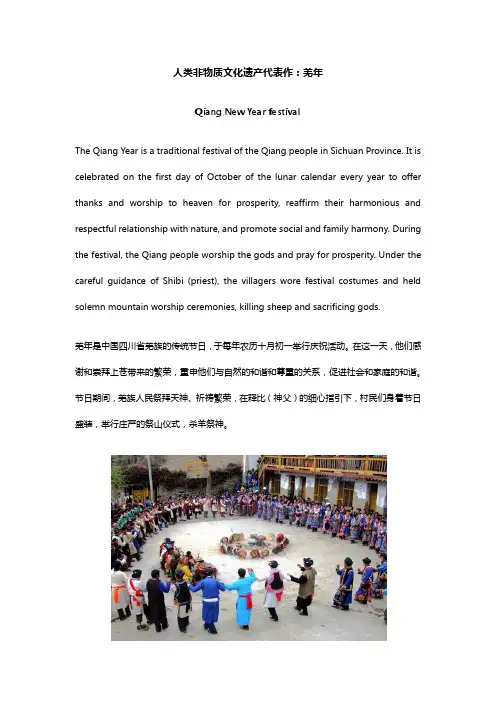
人类非物质文化遗产代表作:羌年Qiang New Year festivalThe Qiang Year is a traditional festival of the Qiang people in Sichuan Province. It is celebrated on the first day of October of the lunar calendar every year to offer thanks and worship to heaven for prosperity, reaffirm their harmonious and respectful relationship with nature, and promote social and family harmony. During the festival, the Qiang people worship the gods and pray for prosperity. Under the careful guidance of Shibi (priest), the villagers wore festival costumes and held solemn mountain worship ceremonies, killing sheep and sacrificing gods.羌年是中国四川省羌族的传统节日,于每年农历十月初一举行庆祝活动。
在这一天,他们感谢和崇拜上苍带来的繁荣,重申他们与自然的和谐和尊重的关系,促进社会和家庭的和谐。
节日期间,羌族人民祭拜天神、祈祷繁荣,在释比(神父)的细心指引下,村民们身着节日盛装,举行庄严的祭山仪式,杀羊祭神。
Then, under the leadership of Shibi, the villagers will dance skin drums and Salang dances. During the activity, Shibi sang the traditional epic of the Qiang nationality, while people sang, drank and enjoyed themselves. On New Year's Eve, the head of each family presides over worship ceremonies, offerings and offerings.然后,村民们会在释比的带领下,跳皮鼓舞和萨朗舞。
【51Talk-用英语介绍非遗文化】人类非物质文化遗产代表作:中医针灸

人类非物质文化遗产代表作:中医针灸Acupuncture and moxibustion of traditional Chinese medicine Acupuncture and moxibustion is a medical method of traditional Chinese medicine, which has been widely used in China, as well as in Southeast Asia, Europe and the Americas.针灸是传统中医的一种医疗手段,除在中国得到广泛应用之外,在东南亚、欧洲和美洲地区也有实践。
Acupuncture and moxibustion theory holds that the human body is like a small universe connected by various meridians. By stimulating the meridians physically, it is possible to promote the self-regulation function of the human body and bring health to patients.针灸理论认为,人体如同一个由各种经络连接起来运行的小宇宙,通过物理刺激经络,就有可能促进人体的自我调节功能并为病人带来健康。
Stimulation methods include using moxa velvet to burn or needling the acupoints of these channels to promote the body to restore balance, thus achieving the purpose of prevention and treatment of diseases.刺激方法包括用艾绒点炙或用针刺就这些管道的穴位,促进身体重新恢复平衡,进而达到预防和治疗疾病的目的。
【51Talk-用英语介绍非遗文化】人类非物质文化遗产代表作:妈祖信仰
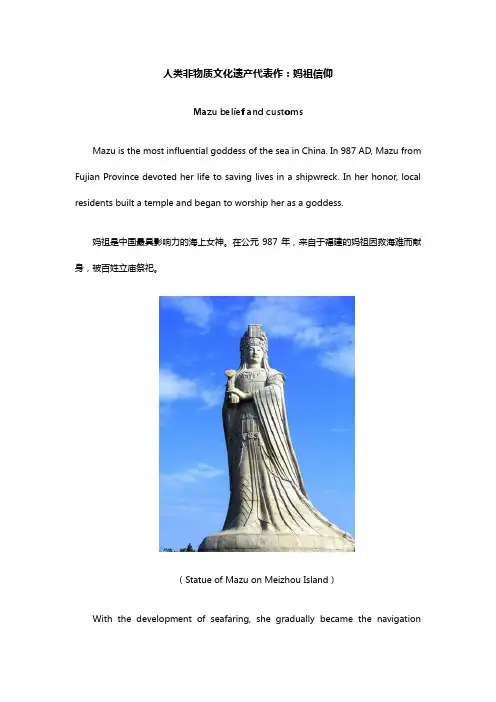
人类非物质文化遗产代表作:妈祖信仰Mazu belief and customsMazu is the most influential goddess of the sea in China. In 987 AD, Mazu from Fujian Province devoted her life to saving lives in a shipwreck. In her honor, local residents built a temple and began to worship her as a goddess.妈祖是中国最具影响力的海上女神。
在公元987年,来自于福建的妈祖因救海难而献身,被百姓立庙祭祀。
(Statue of Mazu on Meizhou Island)With the development of seafaring, she gradually became the navigationgoddess and gained greater influence in coastal southeast China and some regions in southeastern Asian.后随着海运业的发展,妈祖遂成为海神,逐渐成为中国东南沿海及部分东南亚地区的航海保护神。
The custom of Mazu is also known as the Mother Belief, Goddess Belief, Princess of Heaven Belief, Queen of Heaven Belief, Our Lady of the Sky Belief. It is a folk culture dedicated to worship and praise Mazu’s grace, benevolence, and philanthropy, with Mazu palaces and temples as the major venue of various activities, and manifested in relevant customs and temple fairs.妈祖信仰也称为娘妈信俗、娘娘信俗、天妃信俗、天后信俗、天上圣母信俗。
介绍莆田妈祖的英语作文
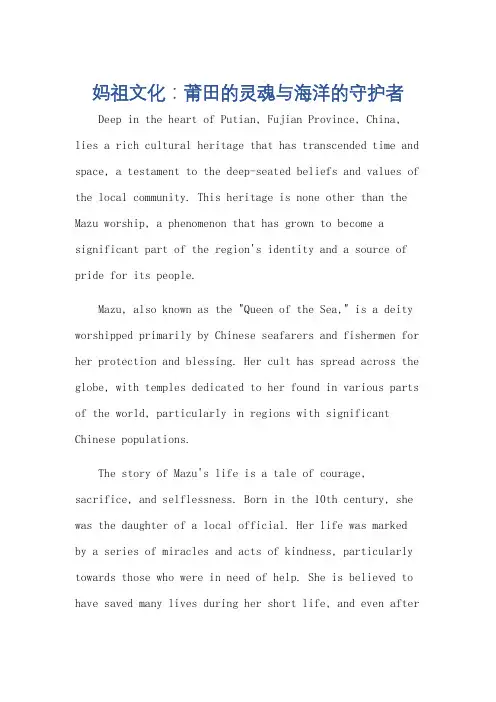
妈祖文化:莆田的灵魂与海洋的守护者Deep in the heart of Putian, Fujian Province, China, lies a rich cultural heritage that has transcended time and space, a testament to the deep-seated beliefs and values of the local community. This heritage is none other than the Mazu worship, a phenomenon that has grown to become a significant part of the region's identity and a source of pride for its people.Mazu, also known as the "Queen of the Sea," is a deity worshipped primarily by Chinese seafarers and fishermen for her protection and blessing. Her cult has spread across the globe, with temples dedicated to her found in various parts of the world, particularly in regions with significant Chinese populations.The story of Mazu's life is a tale of courage, sacrifice, and selflessness. Born in the 10th century, she was the daughter of a local official. Her life was marked by a series of miracles and acts of kindness, particularly towards those who were in need of help. She is believed to have saved many lives during her short life, and even afterher death, her spirit continued to be felt and worshipped by those who believed in her.In Putian, the city where Mazu was born and raised, her cult has taken root and flourished. The Mazu Temple in Putian is one of the most famous and important temples dedicated to her, attracting thousands of visitors from all over the world. The temple is a masterpiece ofarchitectural brilliance, blending traditional Chinese elements with a sense of grandeur and reverence.The festival of Mazu is a particularly auspicious occasion in Putian, celebrated with much fervor and enthusiasm. People from all walks of life come together to pray, offer incense, and seek the deity's blessings for a prosperous and peaceful life. The festival is marked by a series of activities such as dragon and lion dances, traditional music and dance performances, and a grand procession that culminates at the Mazu Temple.The significance of Mazu in Putian goes beyondreligious beliefs. She has become a symbol of the city's rich cultural heritage, a representation of its people's values and aspirations. The cult of Mazu has also had aprofound impact on the economic and social development of the region. The tourism industry in Putian has thrived because of the influx of visitors attracted by the Mazu Temple and the associated cultural activities. Local businesses have also benefited from the influx of tourists, creating jobs and opportunities for the local community.In conclusion, the cult of Mazu in Putian is not just a religious phenomenon; it is a way of life, a source of inspiration, and a bridge connecting the past with the present. It represents the deep-seated beliefs and values of the local community, and it serves as a constant reminder of the importance of unity, peace, and harmony. As the world continues to evolve and change, the cult of Mazu remains a constant in Putian, a testament to the resilience and adaptability of its people.**妈祖文化:莆田的灵魂与海洋的守护者**在中国福建省的莆田市深处,隐藏着一种跨越时空的丰富文化遗产,它是当地社区深深根植的信仰和价值的见证。
妈祖文化英语演讲稿范文
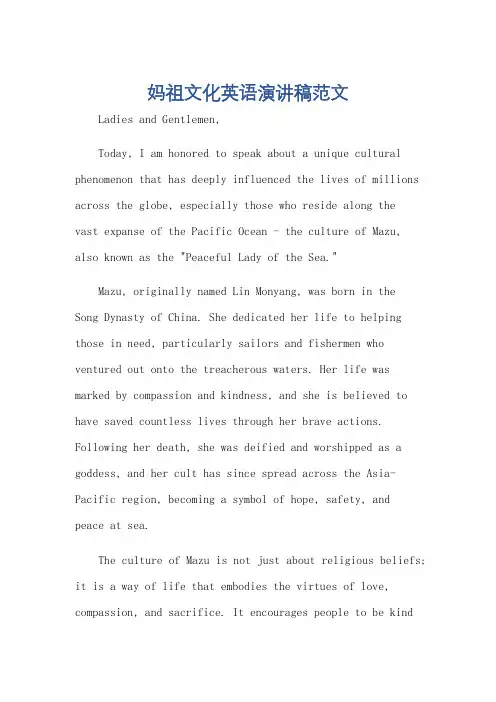
妈祖文化英语演讲稿范文Ladies and Gentlemen,Today, I am honored to speak about a unique cultural phenomenon that has deeply influenced the lives of millions across the globe, especially those who reside along thevast expanse of the Pacific Ocean - the culture of Mazu, also known as the "Peaceful Lady of the Sea."Mazu, originally named Lin Monyang, was born in the Song Dynasty of China. She dedicated her life to helping those in need, particularly sailors and fishermen who ventured out onto the treacherous waters. Her life was marked by compassion and kindness, and she is believed to have saved countless lives through her brave actions. Following her death, she was deified and worshipped as a goddess, and her cult has since spread across the Asia-Pacific region, becoming a symbol of hope, safety, andpeace at sea.The culture of Mazu is not just about religious beliefs; it is a way of life that embodies the virtues of love, compassion, and sacrifice. It encourages people to be kindto each other, to help those in need, and to respect the natural environment. The festivals and rituals associated with Mazu worship are also an important part of this culture, as they bring people together, strengthen community bonds, and promote cultural exchange and understanding.The influence of Mazu culture is felt not only in China but also in Taiwan, Hong Kong, Macau, and many other parts of the Asia-Pacific region. In these places, temples dedicated to Mazu can be found in almost every major city and town. These temples are not just places of worship; they are also centers of cultural activity, where people come together to celebrate, pray, and reflect on the values and principles instilled by Mazu's life and teachings.In today's globalized world, where people and cultures are constantly interacting and influencing each other, the culture of Mazu serves as a powerful reminder of the importance of unity, compassion, and respect for all. It is a bridge that connects people across vast distances and diverse backgrounds, bringing them together under the banner of peace and harmony.As we look towards the future, it is important for usto remember the values and principles that have guided usin the past. The culture of Mazu reminds us that it is through unity, compassion, and respect for all that we can build a better world for ourselves and for future generations.Thank you.**妈祖文化:连接海洋与心灵的桥梁**各位女士、先生:今天,我很荣幸能够为大家介绍一种独特的文化现象,它深刻地影响了全球数百万人的生活,特别是那些居住在广阔太平洋沿岸的人们——妈祖文化,也被称为“海上和平女神”。
用英语介绍莆田妈祖庙作文
用英语介绍莆田妈祖庙作文英文回答:Putian Mazu Temple is a significant religious site located in the coastal city of Putian, Fujian Province, China. Dedicated to the revered goddess of the sea, Mazu,it is one of the most important Mazu temples in the world, attracting millions of devotees and pilgrims annually.The temple's history dates back to the Song Dynasty (960-1279 AD), when it was first built as a small shrine to honor Mazu, a local maiden who was believed to have possessed supernatural powers and protected seafarers. Over the centuries, the temple has undergone numerous expansions and renovations, culminating in the grand complex that stands today.The architectural style of Putian Mazu Temple is a blend of traditional Chinese temple architecture and modern elements. The main hall, known as the "Hall of the HeavenlyEmpress," is a magnificent structure adorned with intricate carvings, colorful murals, and towering columns. Inside, a colossal golden statue of Mazu is enshrined, flanked by statues of her celestial guardians.Beyond the main hall, there are numerous other halls, shrines, and courtyards within the temple complex. Each has its own unique significance and purpose, housing various deities, offering places for worship, and showcasing religious artifacts.One of the most striking features of Putian Mazu Temple is its bustling atmosphere. Throughout the year, the temple is a hub of religious activities, including daily prayers, festivals, and special ceremonies. Devotees from all walks of life come to pay homage to Mazu, seeking her blessings for safe voyages, good health, and prosperity.The temple also serves as a center for cultural exchange and preservation. It houses a museum dedicated to Mazu's life and legacy, as well as a library containing a vast collection of books and manuscripts on Chinese historyand religion.Visiting Putian Mazu Temple is an unforgettable experience that offers a glimpse into the vibrant religious traditions and cultural heritage of China. Whether you area devout pilgrim or simply a curious traveler, the temple's beauty, history, and spiritual significance will leave a lasting impression.中文回答:莆田妈祖庙是福建省莆田市沿海的一座重要宗教场所。
介绍非物质文化遗产端午觉英语
介绍非物质文化遗产端午觉英语The Dragon Boat Festival, also known as Duanwu Festival, is a traditional Chinese festival that has been celebrated for over 2,000 years. It is recognized as an Intangible Cultural Heritage by UNESCO. The festival is held on thefifth day of the fifth month of the Chinese lunar calendar, which usually falls in June in the Gregorian calendar.The Dragon Boat Festival is celebrated with various customs and activities, the most famous of which is the dragon boat racing. This involves teams of rowers paddlingto the rhythm of beating drums, while racing theirbeautifully decorated dragon boats. The origin of this tradition is said to commemorate the ancient poet Qu Yuan, who drowned himself in the Miluo River as a form of protest against government corruption. The locals raced out intheir boats to save him or retrieve his body, and the tradition of dragon boat racing is said to symbolize this rescue attempt.Another important aspect of the festival is the consumption of traditional foods, with the most famous being zongzi. Zongzi are pyramid-shaped glutinous rice dumplings wrapped in bamboo leaves, filled with various fillings such as pork, beans, or dates. The act of making and eating zongzi is a way for people to commemorate Qu Yuan and is an essential part of the festival.Additionally, the festival is also associated with other customs such as hanging up aromatic pouches, wearing five-color silk thread, and displaying images of the deities. These customs are believed to ward off evilspirits and bring good health and fortune.In recent years, the Dragon Boat Festival has gained popularity worldwide, with dragon boat races being held in many countries as a way to celebrate the festival and promote Chinese culture. This has helped to spread awareness of this traditional Chinese festival and its significance as an important Intangible Cultural Heritage.。
介绍中国的世界非物质文化遗产的英语作文
介绍中国的世界非物质文化遗产的英语作文Title:China's World Intangible Cultural Heritage: A Treasure of Humanity China, a country with a rich and ancient history spanning thousands of years, is home to an array of cultural practices and expressions that have been inscribed on the UNESCO List of Intangible Cultural Heritage. These treasures embody the essence of Chinese civilization, reflecting its deep-rooted traditions, beliefs, and artistic achievements. Let us embark on a journey to explore some of these remarkable intangible cultural heritages that China has generously shared with the world.One such gem is Kunqu Opera, often hailed as the "ancestor of all operas." With a history dating back over 600 years, Kunqu Opera is not only a form of musical drama but also a living testament to the evolution of Chinese theater. Its unique combination of vocal music, instrumental accompaniment, and dramatic performance creates a mesmerizing experience for audiences, showcasing the elegance and depth of Chinese aesthetics.Another notable mention is the Chinese Zodiac, an integral part of Chinese astrology deeply intertwined with daily life and cultural celebrations. The twelve animal signs, each representing a year in the cyclic calendar, symbolize different personality traits and are believed to influence individuals' destinies. The Zodiac serves as a cultural touchstone, guiding people's choices, celebrations, and even maritalcompatibility, reflecting the profound influence of astronomy on Chinese society.The art of Chinese paper-cutting, with its intricate designs and symbolic motifs, is yet another masterpiece of intangible heritage. This traditional craft, often associated with festivals and celebrations, embodies the Chinese people's pursuit of auspiciousness and beauty. The delicate patterns, ranging from floral motifs to mythical creatures, not only decorate homes but also carry profound cultural meanings and wishes for prosperity and happiness.Furthermore, the Festival of the Dragon Boat, held annually to commemorate the loyal poet Qu Y uan, demonstrates the deep-seated values of filial piety and patriotism in Chinese society. The festivities, including dragon boat races and the consumption of zongzi (rice dumplings), foster community spirit and cultural continuity, preserving the memory of historical figures and their teachings.These examples merely scratch the surface of China's extensive list of intangible cultural heritages, which also includes acupuncture, Chinese calligraphy, the 24 Solar Terms, and numerous traditional music and dance forms. Each of these practices serves as a vital link between the past and the present, embodying the wisdom, creativity, and spiritual depth of the Chinese people.In conclusion, China's world intangible cultural heritage represents notonly the nation's rich cultural diversity but also contributes significantly to the global tapestry of human achievements. These treasures are a testament to the enduring power of tradition and the continuous evolution of human expression, deserving of our utmost respect, preservation, and appreciation.。
非物质文化遗产的英语作文
非物质文化遗产的英语作文In the tapestry of human culture, intangible cultural heritage stands as a thread of continuity, weaving the past into the present and future. It is the practices, representations, expressions, knowledge, and skills that communities, groups, and sometimes individuals recognize as part of their cultural heritage. This essay delves into the significance of intangible cultural heritage and the importance of its preservation.Firstly, intangible cultural heritage is a living legacy that embodies the traditions, customs, and social practices of a community. It includes oral traditions, performing arts, festive events, and rituals, as well as the knowledge and skills to produce traditional crafts. These elements are crucial for the transmission of cultural values and identity from one generation to another.The preservation of intangible cultural heritage is not merely a nostalgic endeavor but a critical component for the sustainable development of societies. It fosters social cohesion and encourages cultural diversity, which are essential for peaceful coexistence in our globalized world. By safeguarding these cultural expressions, we are ensuring that future generations can learn from the wisdom of their ancestors and the richness of their cultural heritage.Moreover, the recognition and protection of intangiblecultural heritage can play a vital role in promoting tourism and economic development. Local communities can benefit from the income generated by cultural tourism, which can lead to improved living conditions and the revitalization of traditional practices. This, in turn, can contribute to the preservation of cultural heritage, as communities see the value in maintaining their traditions.However, the preservation of intangible cultural heritage faces numerous challenges. Rapid urbanization, globalization, and the erosion of traditional lifestyles threaten the survival of these cultural expressions. To counter these threats, international cooperation is essential. The United Nations Educational, Scientific and Cultural Organization (UNESCO) has taken a leading role in this regard by establishing the Convention for the Safeguarding of the Intangible Cultural Heritage, which aims to raise awareness and provide a framework for international cooperation in safeguarding these cultural treasures.In conclusion, intangible cultural heritage is a priceless asset that enriches our global heritage. It is a testament to the creativity and diversity of human expression. As we move forward, it is imperative that we work together to protect and celebrate these living traditions, ensuring that they continue to thrive and inspire future generations. The preservation of intangible cultural heritage is not just about saving the past; it is about investing in ourcollective future.。
- 1、下载文档前请自行甄别文档内容的完整性,平台不提供额外的编辑、内容补充、找答案等附加服务。
- 2、"仅部分预览"的文档,不可在线预览部分如存在完整性等问题,可反馈申请退款(可完整预览的文档不适用该条件!)。
- 3、如文档侵犯您的权益,请联系客服反馈,我们会尽快为您处理(人工客服工作时间:9:00-18:30)。
人类非物质文化遗产代表作:妈祖信仰
Mazu belief and customs
Mazu is the most influential goddess of the sea in China. In 987 AD, Mazu from Fujian Province devoted her life to saving lives in a shipwreck. In her honor, local residents built a temple and began to worship her as a goddess.
妈祖是中国最具影响力的海上女神。
在公元987年,来自于福建的妈祖因救海难而献身,被百姓立庙祭祀。
(Statue of Mazu on Meizhou Island)
With the development of seafaring, she gradually became the navigation
goddess and gained greater influence in coastal southeast China and some regions in southeastern Asian.
后随着海运业的发展,妈祖遂成为海神,逐渐成为中国东南沿海及部分东南亚地区的航海保护神。
The custom of Mazu is also known as the Mother Belief, Goddess Belief, Princess of Heaven Belief, Queen of Heaven Belief, Our Lady of the Sky Belief. It is a folk culture dedicated to worship and praise Mazu’s grace, benevolence, and philanthropy, with Mazu palaces and temples as the major venue of various activities, and manifested in relevant customs and temple fairs.
妈祖信仰也称为娘妈信俗、娘娘信俗、天妃信俗、天后信俗、天上圣母信俗。
妈祖信仰是以崇奉和颂扬她的功德、善良、大爱精神为核心,以妈祖宫庙为主要活动场所,以习俗和庙会等为表现形式的民俗文化。
During the long history of development, Mazu culture is spread to coastal cities as well as Taiwan, Hong Kong and Macao in our country. It follows the steps of overseas Chinese to more than 20 countries all over the 5 continents of the world. Mazu culture has strong cohesion power for Chinese all over the world, especially in the southeastern districts. After 1000 years, Mazu culture has become an important part of the splendid Chinese culture, as well as cultural bridge and spiritual linkage connection Chinese people all over the world.
在漫长的发展历史中,妈祖文化传播到我国沿海城市以及台湾、香港、澳门。
它跟随海外华人的脚步来到世界五大洲的20多个国家。
妈祖文化对世界各地,尤其是东南地区的中国人具有强大的凝聚力。
一千年后,妈祖文化已经成为中华灿烂文化的重要组成部分,也是连接世界各地中国人民的文化桥梁和精神纽带。
Up to date, the belief has spread to more than 20 countries and regions, and the over 5000 Mazu temples around the world received worships from over 200 million followers. In T aiwan, over 17 million people out of its 23 million population are Mazu believers.
目前,已从湄洲妈祖祖庙传播到世界20多个国家和地区,在全球拥有妈祖宫庙5000多座、信众2亿多人。
在2300万台湾同胞中,有1700万信仰妈祖。
The custom of sacrificial ceremony for Mazu enjoys long history and profound effect. Mazu is very famous, especially in coastal regions, Hong Kong, Macao, Taiwan and southeastern countries, where everybody knows Mazu. Mazu culture and
customs in Meizhou is unique and worth studying on and protecting. It is especially important for promoting the communication between Ming Nan and Taiwan. On the Double Ninth Festival (lunar calendar) of 1987, about 100,000 Mazu believers across Taiwan Straits held the “Mazu Ceremony of the Millennium Festival”, which lasted for one week, in the Mazu Temple of Mei Zhou. An academic discussing meeting on memorial of one millennium after Mazu’s death is held, opening a new prelude for the communication between T aiwan and mainland of China.
妈祖祭祀习俗历史悠久,影响深远。
妈祖非常有名,尤其是在沿海地区,香港、澳门、台湾和东南部国家,那里人人都知道妈祖。
梅州妈祖文化习俗独特,值得研究和保护。
这对促进闽南与台湾的交流尤为重要。
1987年重阳节(阴历),海峡两岸约10万妈祖信徒在梅州妈祖庙举行了为期一周的“千年妈祖庆典”。
妈祖逝世一千周年纪念学术讨论会召开,揭开了台湾与中国大陆交流的新序幕。
On September 30, 1999, in the fourth session of UNESCO Intergovernmental Committee for the Safeguarding of the Intangible Cultural Heritage, “Mazu belief and customs” was added.This is China’s first belief intangible cultural heritage.
在2009年9月30日联合国科教文组织政府间保护非物质文化遗产委员会第四次会议审议,决定将“妈祖信仰”列入世界非物质文化遗产,妈祖信仰即成为中国首个信俗类世界遗产。
